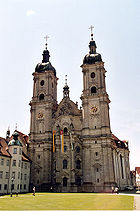The Abbey of St. Gall (German: Sankt Gallen) was for many centuries one of the chief Benedictine abbeys in Europe. It is located in the city of St. Gallen in present-day Switzerland. The Abbey has existed since 719 and became an independent principality during the 13th Century. It was founded by Saint Othmaron the spot where Saint Gall had erected his Hermitage. The library at the Abbeyis one of the richest medieval libraries in the world[1]. Since 1983, it has been anUNESCO Cultural World Heritage Site.
Contents[hide] |
[edit]History
Around 613 an Irishman named Gallus, a disciple and companion of SaintColumbanus, established a hermitage on the site that would become the Abbey. He lived in his cell until his death in 646[2].
Following Gallus' death, Charles Martel appointed Othmar as a custodian of St Gall's relics. During the reign of Pepin the Short, in 719, Othmar founded the Abbey of St. Gall, where arts, letters and sciences flourished. Under AbbotWaldo of Reichenau (740-814) copying of manuscripts was undertaken and a famous library was gathered. Numerous Anglo-Saxon and Irish monks came to copy manuscripts. At Charlemagne's request Pope Adrian I sent distinguished chanters from Rome, who propagated the use of the Gregorian chant.
In the subsequent century, St. Gall came into conflict with the nearby Bishopric of Constance which had recently acquired jurisdiction over the Abbey ofReichenau on Lake Constance. It wasn't until King Louis the Pious (ruled 814-840) confirmed the independence of the Abbey, that this conflict ceased[2]. From this time until the 10th Century, the Abbey flourished. It was home to several famous scholars, including Notker of Liège, Notker the Stammerer, Notker Labeoand Hartker (who developed the Antiphonal liturgical books for the Abbey). During the 9th Century a new, larger church was built and the library was expanded. Manuscripts on a wide variety of topics were purchased by the Abbey and copies were made. Over 400 manuscripts from this time have survived and are still in the library today[2]. ......

댓글 없음:
댓글 쓰기